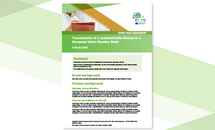Risk assessment: SARS-CoV-2 - increased circulation of variants of concern and vaccine rollout in the EU/EEA, 14th update
This risk assessment provides an overall update on the COVID-19 situation in the EU/EEA, including latest data on the situation with SARS-CoV-2 variants of concern covered by previous targeted risk assessments.
Executive Summary
Several EU/EEA countries have observed a decline in the overall incidence of SARS-CoV-2 in recent weeks, most probably due to the impact of tightened non-pharmaceutical interventions (NPIs). Nonetheless, the epidemiological situation is still of serious concern across the EU/EEA, with the majority of countries still experiencing high or increasing notification rates in older age groups and/or high death rates. Although vaccine rollout has started in all EU/EEA countries, targeting priority groups based on their risk of developing severe disease (the elderly and residents in long-term care facilities) as well as healthcare and other front-line workers, it is still too early to detect an impact on COVID-19 mortality or hospitalisations.
While most countries are currently seeing a decline in overall infections as a response to NPIs, the introduction and increased spread of new SARS-CoV-2 variants first identified in the United Kingdom (B.1.1.7), South Africa (B.1.351) and Brazil (P.1) has raised concerns. As suggested by recent anti-lockdown protests and civil disturbances in some European cities, pandemic fatigue could adversely affect the continued acceptance of and compliance with NPIs by the population.
Since 21 January 2021, EU/EEA countries have observed a substantial increase in the number and proportion of SARS-CoV-2 cases of the B.1.1.7 variant, first reported in the United Kingdom. Ireland reports B.1.1.7 to be the dominant circulating SARS-CoV-2 strain and, based on growth trajectories observed, several other countries are expecting a similar situation in the coming weeks. The variant B.1.351 has also been increasingly reported in EU/EEA countries, often, but not only, linked to travel, and it has also been associated with outbreaks. The variant P.1 is so far being reported at lower levels, possibly because it is mainly linked to travel exchange with Brazil, where it appears to be spreading.
The B.1.1.7 variant appears to be more transmissible than the previously predominant circulating strains and may cause more severe infection. Several countries where the variant has become dominant have seen rapid increases in incidence. This has resulted in increased hospitalisations, overstretched health systems and excess mortality. B.1.351 is also associated with increased transmissibility. In addition, there is evidence pointing to the potential for reduced effectiveness for some of the COVID-19 vaccines with this variant.
Risk assessed in this update
Due to the increased transmissibility, the evidence of increased severity and the potential for the existing licensed COVID-19 vaccines to be partially or significantly less effective against a variant of concern (VOC), combined with the high probability that the proportion of SARS-CoV-2 cases due to B.1.1.7 (and possibly also B.1.351 and P.1) will increase, the risk associated with further spread of the SARS-CoV-2 VOCs in the EU/EEA is currently assessed as high to very high for the overall population and very high for vulnerable individuals.
Modelling analysis shows that unless NPIs continue, or are strengthened in terms of compliance during the coming months, a significant increase in COVID-19-related cases and deaths in the EU/EEA should be anticipated. Although vaccination will mitigate the effect of replacement with more transmissible variants, and seasonality could potentially reduce transmission during the summer months, easing measures prematurely will lead to a rapid increase in incidence rates, detection of severe cases and mortality. Delays in vaccine procurement, distribution and administration, should they occur, would also delay the option to ease NPIs. Rapid vaccine deployment among priority groups is needed to reduce hospitalisations, ICU admissions and deaths due to COVID-19.
Options for response
Based on the current epidemiological situation in the EU/EEA with the increased circulation of more transmissible variants, immediate, strong and decisive public health interventions are essential to control transmission and safeguard healthcare capacity. This will involve all EU/EEA countries ensuring that layered NPIs are strengthened and maintained in the coming months in order to reduce SARS-CoV-2 incidence to the lowest levels possible, thereby also minimising the opportunities for new variants to emerge.
Optimising the implementation of NPIs, including issues related to community use of facemasks and school settings, is essential. Test and trace approaches, including strong surveillance and sequencing, remain the cornerstones of the response. Travel should not be undertaken by people who are ill or who have had recent contact with COVID-19 cases. Furthermore, ECDC recommends that non-essential travel should be avoided as part of general physical distancing measures in the community. In time, targeted and robust vaccination programmes will enable the easing of NPIs.
Variants against which current licensed vaccines might have a reduced efficacy, as observed for some vaccines with the B.1.351 variant first identified in South Africa, will probably continue to emerge in the future. This should be mitigated by designing next-generation vaccines with mutated spike sequences and using alternative viral antigens. Consideration should also be given to their use either as booster doses for those vaccines which have already been developed and are being administered, or, if needed, for the primary series.
Increasing levels of pandemic fatigue need to be properly addressed as a matter of urgency if further waves of infection are to be avoided and population compliance is to be maintained. Public expectations about the likelihood of easing restrictions need to be carefully managed. To facilitate this, authorities should make systematic efforts to ensure that they have a good understanding of community perceptions of the pandemic, the NPIs in place and COVID-19 vaccine acceptance through ongoing behavioural research.







